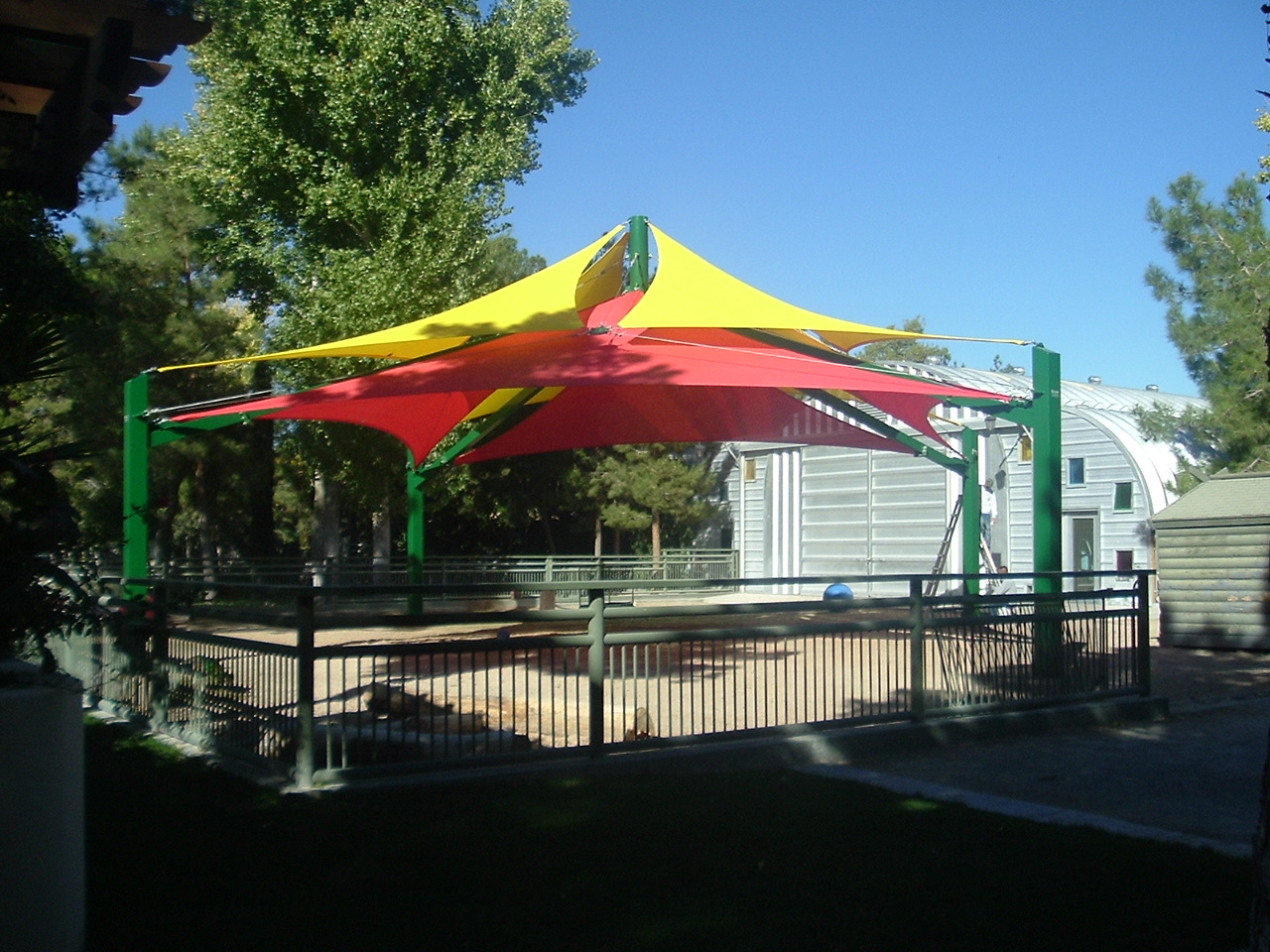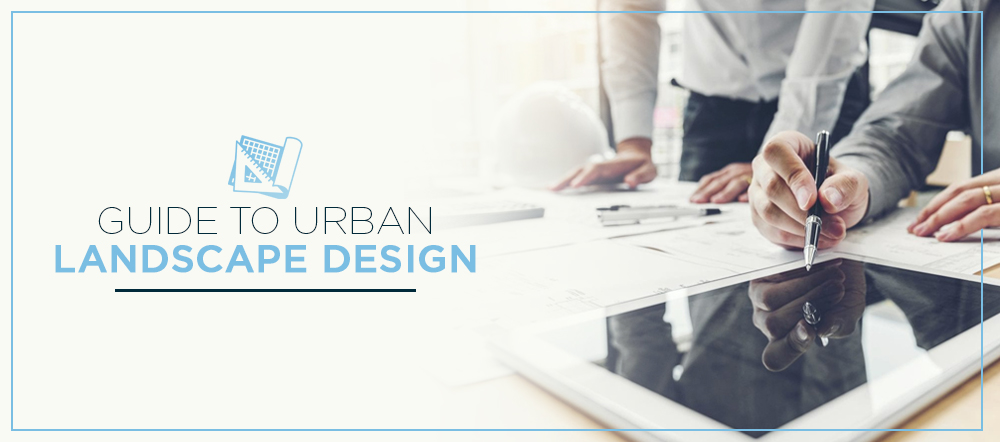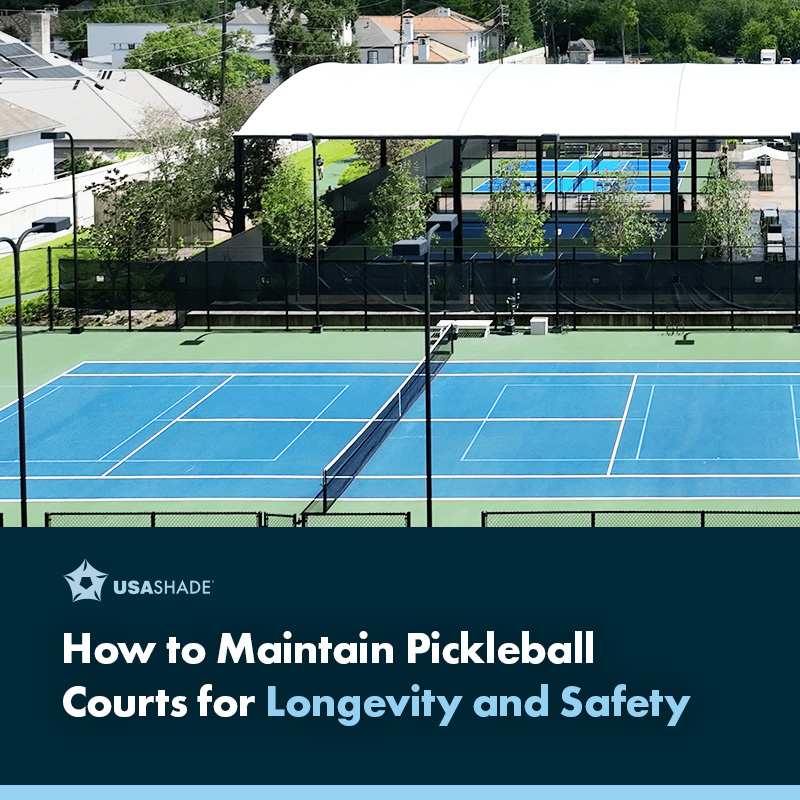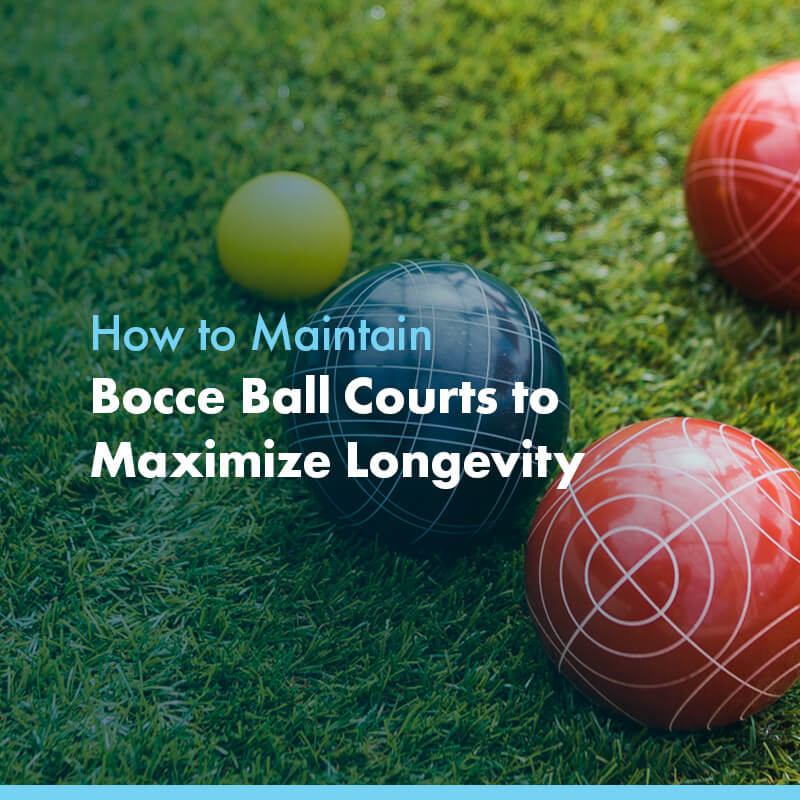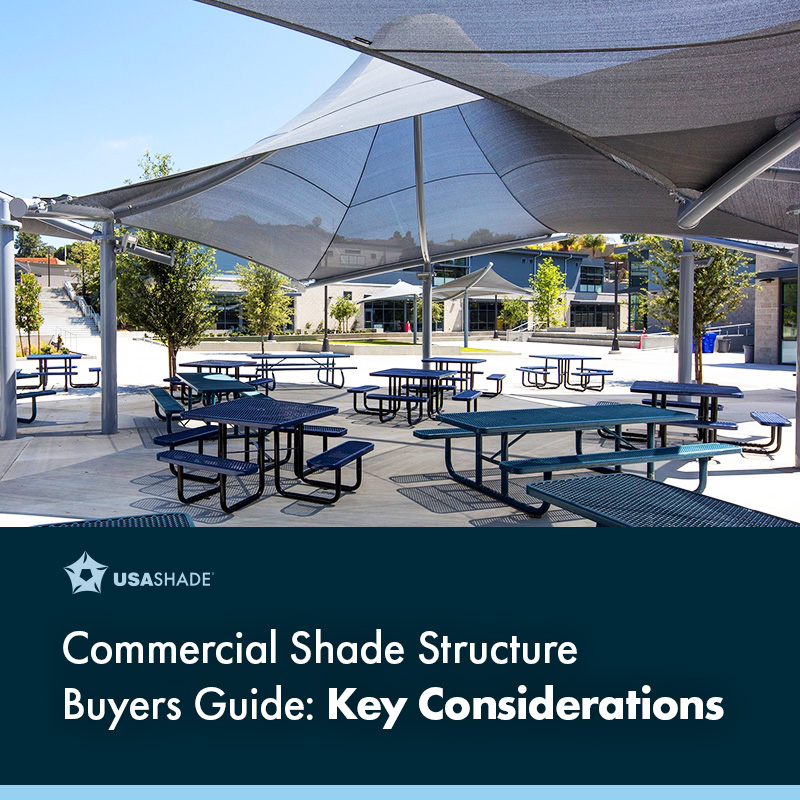Urban landscaping is so much more than an effort to beautify city streets — it’s essential to a city’s operation. Urban landscape design refers to the planning, designing, and implementation of a city’s greenways, plants, and other landscaping elements. Well-executed urban landscape design takes into consideration visual appeal, connections to the local community, the natural ecosystem, existing infrastructure, and the everyday lives of those who live and work in the city to create the most impactful site-specific layout.
Your surrounding environment has an impact on your everyday life. For example:
- Strategically placed trees and shade structures provide much-needed shade from the sun at places like bus stops, playgrounds, and park benches.
- Specific plants, colors, and flowers you see during your commute or on a walk livens the environment and can elevate your mood.
- Parks offer a communal outdoor space to play, gather, and explore nature and in addition to providing a natural habitat for wildlife.
Landscaping also impacts urban design elements that are not always for a visual purpose. For instance, strategically placed trees for shade also minimize soil erosion and help control stormwater runoff. Colorful flowers you may see on your daily commute help capture and purify water and clean the air. Even the sidewalks you walk on were included in site planning for a specific reason. Landscape architects and cities carefully consider all the elements of urban landscape design. That way, designers can layer the landscape, natural ecosystems, and infrastructure into a single, cohesive site-specific design plan.
In this urban landscape design guide, we will take a closer look at the different elements, principles, challenges and concepts of urban design and landscaping.
Read the full article or jump to a specific section:
- What Are the Elements of Urban Design?
- The Basic Principles of Urban Landscape Design
- Steps in Urban Planning
- What Are the Challenges of Urban Planning?
- Enhance Your Project With Shade Solutions From USA SHADE & Fabric Structures
What Are the Elements of Urban Design?
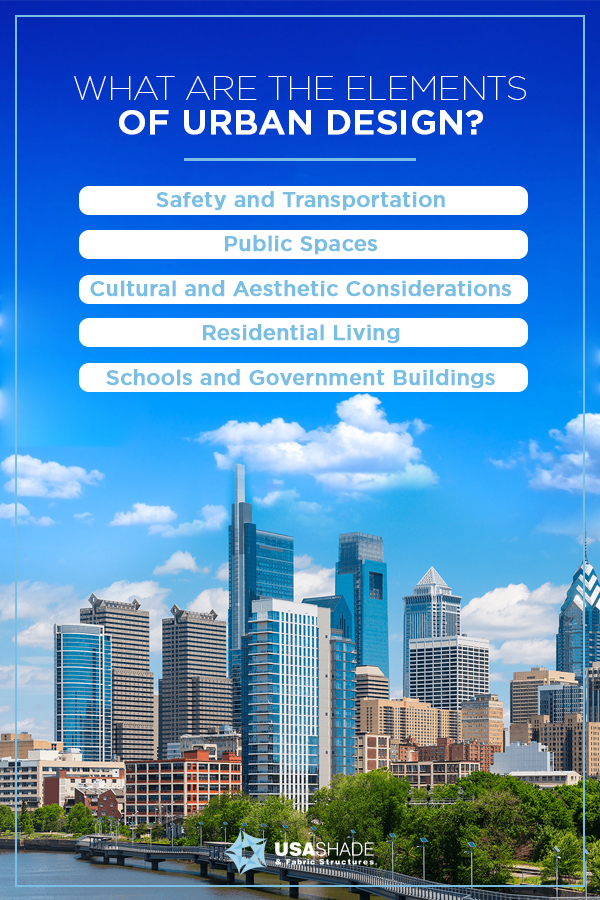
Every aspect of a city’s essential functions and characteristics must be considered during the urban design process, including safety and transportation, public spaces, cultural and aesthetic considerations, residential areas and important city buildings.
1. Safety and Transportation
Urban designers and landscape architects work alongside city officials and state departments to ensure a city space is safe and usable. Key safety and transportation factors include:
- Streets and sidewalks: The location of sidewalks and streets, the number of lanes each road has, the street types, and material used to construct roadways and sidewalks are all important considerations when it comes to urban design.
- Parking lots: Cities consist of private, commercial, and public parking spaces. This often includes parking garages, long-term covered parking, and other pay-to-park structures.
- Signs: Urban signage, such as road signs, are often required to be placed in specific locations. Commercial signage is usually placed near businesses and in areas where a passerby can clearly see it.
- Transportation infrastructure: Urban design architects work with city officials and transportation experts to ensure proper placement of all railroad crossings, stoplights, intersections, crossways, and other necessary transportation infrastructure. Some cities have unique transportation requirements to consider, including horses and carriages or public trolley systems.
2. Public Spaces
Public spaces are areas within a city where people can gather, including parks, beaches, waterfront areas, town squares, fountains and more. Urban landscaping considerations for public spaces include:
- Site Amenities: Site amenities include benches, public mailboxes, trashcans, standing maps of the city and information kiosks. These items are placed according to where they may be most useful and easily accessible on foot.
- Parking: Public areas require access to parking spaces. Whether an urban center incorporates public lots or pay-to-park garages, it’s essential that sidewalks connect these places to the rest of the city and that these areas are well-lit.
- Restrooms: Public restrooms with important features, such as baby changing stations, can be strategically planned throughout a city for general public use. They are especially important in public spaces, such as parks, beaches and outdoor public entertainment venues that draw in visitors who tend to stay for extended periods of time.
3. Cultural and Aesthetic Considerations
Urban design can be practical for function of space, but it can also have a distinctive visual presence. The way a city is presented reflects the values and characteristics of the people who live and work there. A beautiful urban space can also make residents feel good about their community and can also attract tourists, college students, and businesses, which boosts the local economy.
Examples of cultural and aesthetic considerations during urban design include:
- Public artwork: City artwork may consist of wall murals, permanent art installations, live performances, and temporary exhibits. Public artwork is a great way to add visual appeal to outdoor spaces.
- Historical monuments: Monuments within a city speak to the culture and values. This can include historical statues, plaques, or historic architecture. These items are often located or placed where they are accessible to both residents and visitors.
- Local colleges and universities: If a city houses one or more colleges or universities, it is often designed to incorporate the unique flow of students on campus and access to areas nearby. Aesthetic design considerations on campuses and nearby areas may include school colors in landscaping or urban decor, plenty of sidewalks or public transportation routes connecting the college campuses to the rest of the city, or a visually appealing downtown area.
- Culture: Culture plays an important role in shaping a city’s overall landscape design. Take New Orleans, for example. This city is known for its festive celebrations, historic tours, and Southern architecture. Public spaces are designed to reflect these cultural elements including brightly colored plants and hanging ferns, sidewalks and benches in popular parade areas, and plenty of green spaces for public artwork and musical performances.
- Landscaping: While landscaping serves a practical purpose, it is also the easiest way to make an urban space look and feel more natural and inviting. This may include the placement of trees nears streets, aromatic flowers, hanging plants, bushes and shrubbery, mulch, water features such as foundations, and more.
4. Residential Living
Urban design decisions are often made with a city’s residential population in mind. Consider the following elements for residential neighborhoods:
- Noise and safety: It’s helpful to avoid designing a residential neighborhood to be one street away from major construction zones, industrial parks or places with heavy, hazardous traffic. These places can be disruptive, loud, and compromise the safety of the residents.
- Commute: Residential developments and neighborhood landscapes can be designed with a worker’s commute in mind. If most of a city’s residents are employed downtown, roads, sidewalks, and neighborhoods can be designed with an easily commutable route or near the main thoroughfare to and from downtown.
- Proximity: Many residents prefer to live near specific amenities and necessities, such as grocery stores, hospitals, schools, and churches. Placing sidewalks, roadways and greenways that create access from neighborhoods to these urban amenity destinations can make life easier for city residents.
5. Schools and Government Buildings
The location of schools and government buildings plays a significant role in how the landscape is designed within a city. For example, post offices are typically in easy-access areas while fire stations are usually within close proximity of high-population residential areas.
Public building locations to consider within an urban landscape design are:
- Post offices
- Police stations
- Fire stations
- Public and private schools
- Libraries
- Council buildings
- Town halls
- Newspaper and media offices
It is worth noting that many of these places are also considered public gathering spaces and may overlap with elements of urban landscaping. Libraries often have flowerbeds and surrounding green spaces and post offices may have benches and outdoor mailboxes near sidewalks.
The Basic Principles of Urban Landscape Design
Design specifics vary from project to project, but most landscape architects strive to preserve and utilize the natural ecosystem, enhance the daily life of city dwellers, and establish a practical and sustainable landscape that is visually appealing.
1. Preserve and Utilize the Natural Ecosystem
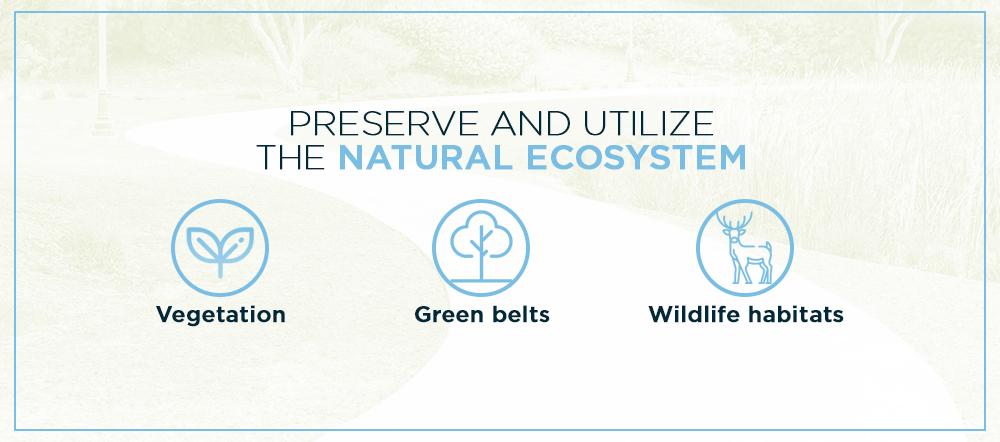
Architects carefully consider a city’s natural ecosystem, including native plants, wildlife habitats, and existing microclimates. They can use these elements to preserve and protect the ecosystem and improve the lives of residents in the city. To do so, designers focus on how an area’s natural ecosystem looks and functions. Although it’s not possible to preserve everything in an urban development situation, it’s crucial that designers and landscapers take into account ecosystems that have the most to lose, such as endangered plants or animals.
Urban landscaping can promote this principle with the following:
- Vegetation: Trees and plants are porous, help slow down stormwater, and transfer it back to the ground. This reduces hazardous runoff, which can damage a city’s drainage system or carry harmful pollutants into a river, ocean or lake. Plants purify this water and can use it to replenish a city’s natural water supply. One study suggests using plants to manage stormwater can be more affordable and effective than conventional stormwater management systems. Trees also create natural shade in otherwise unshaded areas. The shade is comfortable for visitors and residents and can reduce energy costs associated with cooling homes and businesses. Vegetation systems also work to filter pollutants like carbon dioxide out of the air, which promotes a cleaner, healthier environment for all.
- Green belts: Green belts refer to preserved wildlife corridors, streams, parks, wetlands, coastal dunes and other natural spaces in a city. Green belts are essential for allowing wildlife to move safely across the landscape. They also promote a sense of connectivity between a city and its natural ecosystem.
- Wildlife habitats: Urban landscape design works with the natural ecosystem to provide shelter for wildlife and promote biodiversity. To do this, designers consider the native plants and animals the city shelters. By preserving or providing homes and food sources for wildlife and insects, urban landscaping can ensure species like honeybees, butterflies and songbirds continue to thrive and bring pleasure to city dwellers.
2. Enhance the Daily Life of City Dwellers
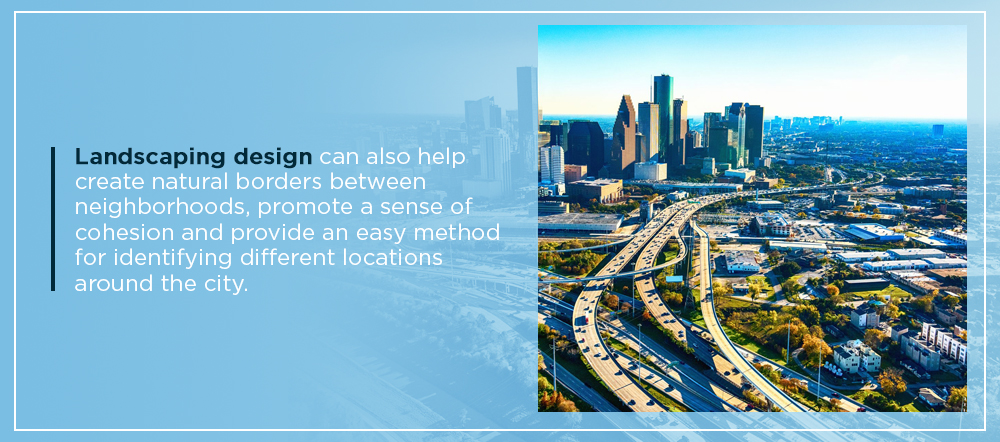
Landscape designers may ask themselves questions throughout the site planning process, including:
- How will this landscape design benefit the people who live in this city?
- In what ways could this landscape design harm or inconvenience residents and businesses?
- What does this landscape design say about the local culture or values?
- Does this landscape design promote a sense of place and identity?
A well-crafted landscape can provide several benefits, including:
- Health: Numerous studies report that spending time in nature is excellent for your health. It can lead to decreased stress levels, reduced blood pressure, better asthma management, a clearer mind and a feeling of overall peace. When a city offers plenty of green space and walkways, residents are also likely to take advantage of these areas for walking and jogging. This can lead to lower obesity rates and heart health benefits.
- Recreation: City dwellers require more than access to work and home — they also want things to do. Landscaping can promote and enhance recreational opportunities like beach access, walking trails, river and lake access, community gardening and birdwatching.
- Pleasure: Landscaping can provide practical benefits like noise buffering between neighborhoods. Beautiful landscapes also make people happy with the flowers, trees and the wildlife they provide. This happiness can lead to a stronger connection to the land and to each other.
Landscaping design can also help create natural borders between neighborhoods, promote a sense of cohesion and provide an easy method for identifying different locations around the city. A strong sense of social cohesion and community are linked to lower crime rates, more positive neighbor interactions and even better health.
3. Establish a Practical and Sustainable Landscape
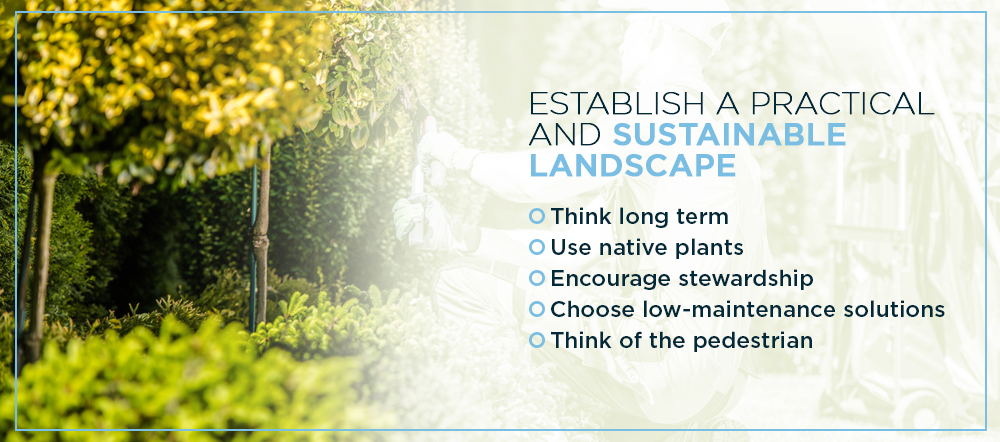
When a landscaping design is practical and sustainable, it is more likely to benefit the city for years to come. Here are some helpful tips for urban landscape design:
- Think long term: One of the most important principles of urban design is that the landscape makes sense in a long-term context. Cities are constantly changing, whether from a natural disaster, shifting economies, changing infrastructure or city-wide renovations. It’s helpful to design a landscape and create a maintenance plan that can adapt and respond to these changes.
- Use native plants: Whenever possible, incorporate native plants into your landscape design. These plants may adapt better to the climate and work naturally with the local wildlife. Native plants may also attract tourists and new residents to the area.
- Encourage stewardship: Encourage community stewardship to prolong the well-being of the landscape design. This includes making thoughtful decisions about construction projects, having zero-litter initiatives and cleanup volunteers, providing food and shelter for birds and other animals on private residencies and encouraging involvement in protecting the city greenways and public spaces.
- Choose low-maintenance solutions: Consider low-maintenance solutions for your landscape, including plants like climate-specific grass, hostas, sedge and wildflowers. Create natural borders out of stone or wood. You could also consider rock gardens and other plant-free landscaping ideas.
- Think of the pedestrian: What may feel like small design decisions can have a huge impact on a pedestrian’s daily life. For example, placing sidewalks in a dry area away from mud and ground depressions can create a more comfortable experience when walking in the rain. Placing benches in areas that receive shade and minimal wind ensures a pedestrian can sit comfortably for however long they need. Mulch can be used to control dust in dry or grass-free areas around town.
4. Create Stylish and Aesthetically Pleasing Spaces
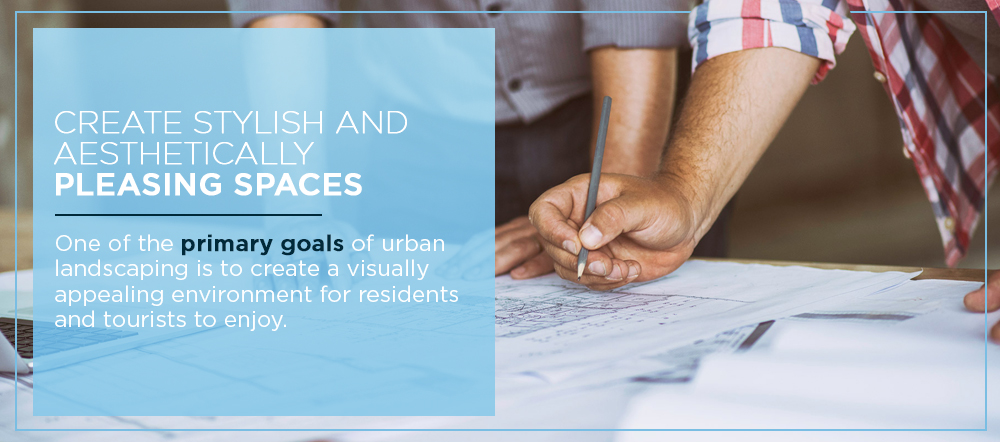
One of the primary goals of urban landscaping is to create a visual impact in an environment for residents and tourists to enjoy. Consider the following advice for urban landscape design to create the perfect plan for your city:
- Balance and scale: Strive for balance in the shapes, sizes, and numbers of each element included in your design. This includes incorporating different textures, as well as harsh and soft lines and curves.
- Color and contrast: Color and contrast are powerful landscape design tools. The color palette you choose can evoke feelings of calm, create a dramatic pop of color or create a softer, subtle effect.
- Local architecture: Take a look at the local architecture for inspiration and urban landscaping ideas. Cities with historic cathedrals and ancient trees, for example, will call for different landscaping than a modern, minimalist college town.
- Focal point: Urban landscape design usually calls for a focal point, especially when creating a landscape for a downtown area or public space. Popular focal points include ornate fountains, parks, riverfront boardwalks, monuments or famous landmarks.
- Seasonal changes: Create a landscape that will be visually pleasing throughout each season. This may include incorporating evergreen plants to maintain interest throughout the winter, choosing plants that will provide autumn color, and incorporating spring-blooming flowers.
Steps in Urban Planning
There are two types of plans in urban planning: the initial, pre-development plan and the more formal plan that comes later on. One is not more important than the other — in fact, the decisions you make during the pre-planning stage are essential for seeking legal approval and moving your design to the formal stages of implementation.
Pre-Planning
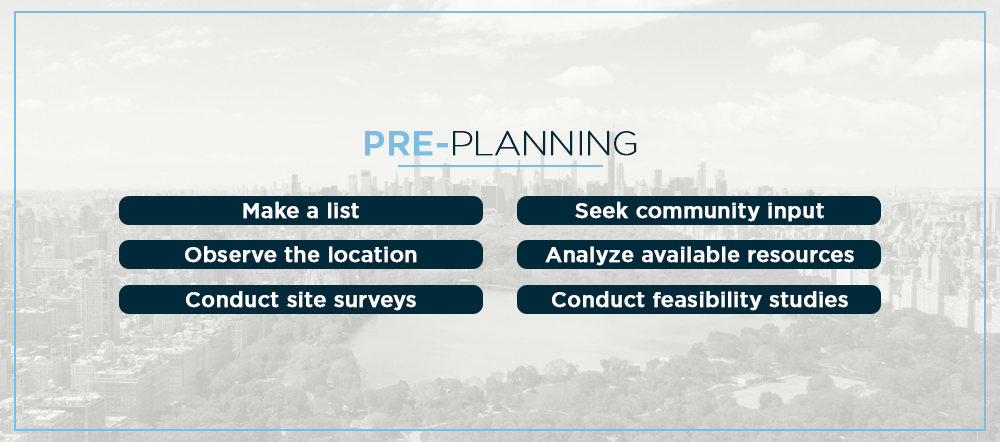
Follow these steps during the pre-planning phase:
- Make a list: Create a list of current concerns, needs and goals for your urban center, as well as steps you need to take to address them. This will guide your decision making through the design process.
- Observe the location: If you’re responsible for designing a small portion of an existing city, it’s important you get a feel for what’s going on in the rest of the area. What other design choices have been made? What is currently working or not working in those spaces?
- Conduct site surveys: A site survey in urban planning is when a surveyor visits the designated landscaping location and assesses important information about it. This may include the topography, zoning restrictions and requirements at the local, county and statewide levels. A site survey also involves assessing the local climate and weather conditions, which informs the building material selection and project work calendar.
- Seek community input: Community input is a powerful tool during landscape design, especially if you’re crafting a design for a city you’re unfamiliar with. Ask the community what they would like to see implemented in your plans. Don’t forget to involve key stakeholders, including the city administration, urban developers or investors.
- Analyze available resources: Analyze all available resources, including your allocated budget, building materials and required labor.
- Conduct feasibility studies: A feasibility study takes into account all relevant factors, including the site survey information, available resources, community input, site locations and more.
After making preliminary plans, you can begin drafting your design and creating a master blueprint. Continue working with stakeholders, the community and local experts during this phase.
Formal Planning
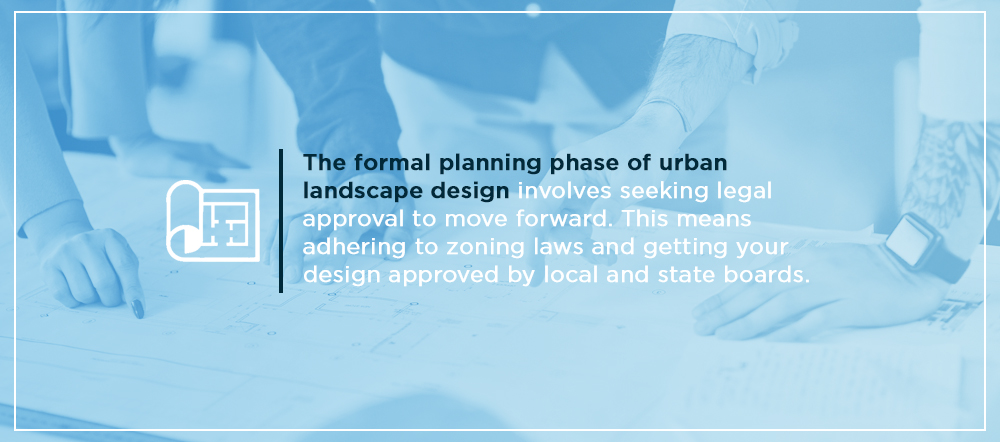
The formal planning phase of urban landscape design involves seeking legal approval to move forward. This means adhering to zoning laws and getting your design approved by local and state boards. You will likely present your blueprint and design plans to a group of stakeholders as well. You may have to redraft your design a few times until all requirements are met. Once the plan is approved and you receive the required permits, it’s time to bring your design to life.
Implementation
The implementation stage is when you actualize your landscape design. To do so, you gather resources and hire labor. Many landscape architects enjoy the implementation phase because it allows them to answer questions that come up during building or planting and have full control over their hard work.
Quality Management
Once your landscape is installed, it must be maintained. Quality management includes creating a plan for monitoring the design and hiring caretakers to mow, fertilize and water the plants. Designing an effective quality management plan is not always up to the landscape architect. You will likely work with city officials to establish a maintenance schedule.
What Are the Challenges of Urban Planning?
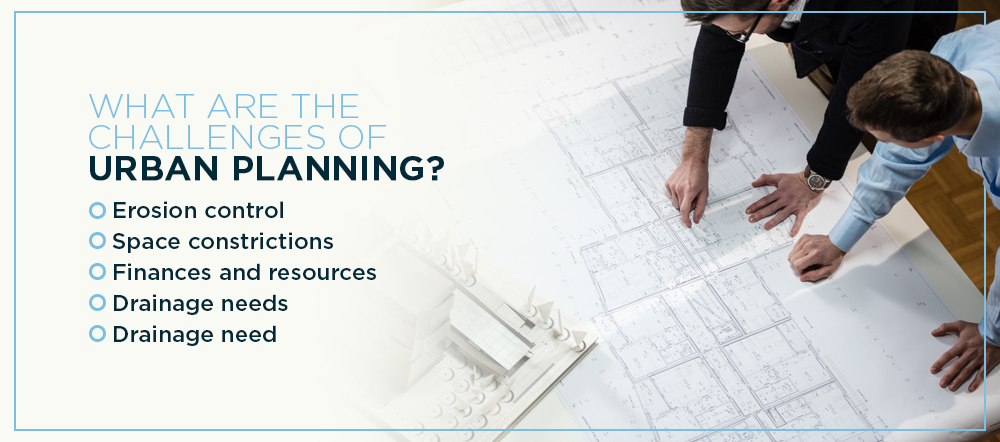
Some of the limitations of urban landscape design include:
- Erosion control: Erosion occurs naturally during storms or from coastal tides. Make sure your design includes erosion control, such as strategically placed trees or retaining structures.
- Space constrictions: Due to zoning laws and property lines, you may not have as much space as you would like. This is why it’s important to conduct a site survey before drafting the design.
- Finances and resources: Unfortunately, budget constrictions are often one of the biggest challenges in urban landscape planning. In addition to considering your landscape design budget, consider whether the city can afford the required ongoing maintenance for your design.
- Drainage needs: Drainage helps to avoid flooding and prevent polluted runoff from reaching the water supply in commercial urban garden architecture. Ways to address drainage include planting drain trees or constructing rain gardens in depressed areas of the ground.
- Harsh sunlight: Harsh sunlight can be a tricky urban landscape design restriction to address. Without shade, it can be difficult to grow plants and create thriving green spaces. Trees can be an excellent source of shade — but they are not always feasible solutions due to location restrictions, budget confinements or the local climate. A more adaptable sunlight solution is high-quality shade structures. Shade structures are made out of durable fabric and can be installed almost anywhere, making them ideal for any landscape design.
Enhance Your Project With Shade Solutions From USA SHADE & Fabric Structures
Place a shade structure anywhere your design requires shade without sacrificing style or space, such as:
- Near bus stops on the street
- In public gardens and parks
- At playgrounds and in schoolyards
- At sports and entertainment venues
- Along promenades
- In popular gathering spaces, like downtown or town square
- Surrounding outdoor amphitheaters
- At fairgrounds and outdoor event centers
- Over a greenhouse or garden
- In and around parking lots
- Along sidewalks and other walkways
The Architectural Specialist Division at USA SHADE is here to assist you in integrating shade structures into your designs. We can help you develop a visually appealing concept that meets your client’s needs and provides a long-lasting shade solution.
Check out our Architecture Lookbook or request your quote today.


